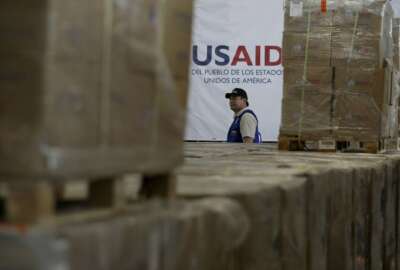How USAID helps Africa with climate resilience
The U.S. Agency for International Development concentrates many of its overseas efforts on helping nations with resilience and to anticipate disasters.
The poorer a nation, the less ability it has to anticipate and mitigate disasters. That’s one reason the U.S. Agency for International Development concentrates many of its overseas efforts on helping nations with resilience and the ability to anticipate disasters. Jacqueline Musiitwa, USAID’s deputy assistant administrator for the Bureau of Humanitarian Assistance, joined the Federal Drive with Tom Temin to discuss more.
Interview transcript:
Tom Temin: And I wanted to concentrate on that first idea we mentioned and that is anticipating disasters. In the United States and some of the EU nations and so on, we’re used to having fantastic weather predictions and all kinds of sensors all over the place so that we know when a hurricane is coming. Can’t control it, but we know about it early. Tell us about some of the work in undeveloped or less developed nations where you can help them build that capacity.
Jacqueline Musiitwa: So I think maybe to start, I’ll put in context how the Bureau of Humanitarian Assistance ends up supporting our partners around the world on climate resilience. If you think about it, it’s kind of a four-pronged approach. One is expanding and improving climate early warning and early action systems. Another is accelerating humanitarian assistance. The third is strengthening coherence around the climate and humanitarian development and peace nexus. And the fourth is really supporting our local partners and the communities that are at the front lines. Now, with respect to early warning systems, we think it’s really important not only to support the technologies that people can access, but also to support the systems that are making sure that the right networks, for instance, through the U.N. and others are basically capacitated to ensure that information is getting to the ground. So one initiative that we’ve been engaged in is supporting the United Nations secretary-general’s Early Warning for All initiative, where we invest in a flash flood guidance system that enables national authorities to monitor as well as provide climate related flash flood early warnings. And that ends up impacting about three billion people across 74 different countries. When you think of kind of the work that VHA does, we work a lot in emergency situations. And so in the case of flooding, it’s really making sure that when flooding is detected, people within those communities are notified and they’re able to act accordingly.
Tom Temin: Well, let me just ask this to when there’s a network component of informing people and there’s also a technical component of whatever sensors and weather forecasting and etc., is part of that training locals to be able to operate and interpret the data that these types of systems produce?
Jacqueline Musiitwa: Absolutely. We work very closely with disaster management institutions in different countries, not only to provide capacity building, but also to identify gaps that they have and see how we might work either as a bilateral partner or with other donor partners to increase their capacity. We also work very closely with technology firms such as Google, for instance, that is a member of PREPARE, which is the president’s initiative focused on resilience and adaptation. Really to use evolving technologies to help us better understand changes and trends, but also to help us disseminate information based on networks that they already have.
Tom Temin: And by the way, when you look at climate effects and the need for resilience for them, is flooding the most common type of disaster that we’re seeing more of, do you think?
Jacqueline Musiitwa: We’re seeing everything. And it really depends on the geography. We are seeing everything from hurricanes in places that haven’t typically experienced hurricanes as we saw in Florida a couple of months ago. I was most recently in South Africa and Zimbabwe and they are experiencing an extreme drought, probably the worst drought conditions that they’ve seen in the last decade or so. A couple of months ago, I was in Niger and Burkina Faso, and they’re experiencing the worst flooding that the central Sahel region has experienced in a while. So I think as we go through different weather patterns, be it El Nino right now in southern Africa and then moving into La Nina next year, I think we are bracing ourselves for everything that might come and really trying to make sure that the local authorities and the local communities we are working with are better able to adapt to whatever might come.
Tom Temin: We’re speaking with Jacqueline Mosquito. She is deputy assistant administrator for the Bureau of Humanitarian Assistance at the U.S. Agency for International Development. And I wanted to ask you about another one of the four kinds of. Pillars for this climate resilience that you’re building, and that is strengthening coherence across the climate and humanitarian development peace nexus. Put that in English for us.
Jacqueline Musiitwa: In English, that basically means we understand that there is a connection between climate fragility as well as people migrating to different parts to be more safe and get away from climate effects. But also in a lot of cases, there is a nexus with conflict and fragility that results as fragility that is a result of conflict. And so from our work, what we’re trying to do is move from providing immediate humanitarian assistance, so providing food aid as well as other immediate types of aid and really trying to graduate people moving from that to more peaceful situations, but also where they are able to start planning for their own futures, both from a climate planning perspective but also from a peace perspective. And so we have three pilots right now that are going on Madagascar, which experiences extreme climate fragility and high levels of poverty. The Democratic Republic of Congo, which not only experiences climate fragility but also in the east, experiences conflict, fragility and Somalia, which in addition to climate, has also had ongoing conflict related fragility. And we’re using these as examples to really figure out how do we start to program and make wins in those areas for people that are continuing to live in situations that are really tough, but really helping them cope with the situations that they’re living in, such that we can start to see some developmental gains and we can move from providing food aid to helping them, for instance, with climate resilient and climate smart agriculture so they can start to grow food that they can see over a number of crop seasons.
Tom Temin: Right. And many of those areas, the basic violence which results from the political conflicts just afflicts the normal people. Someone going out into the woods to try to find water and they’re raping gangs and horrible stories coming. And so in choosing partners, I mean, that’s what USA does, is find local partners to kind of carry out these missions and plans. It must be difficult to make sure that the partners are neutral and that also they know the terrain to make sure that there’s some way of effectively delivering what it is you need to deliver and them not getting caught up in these conflicts.
Jacqueline Musiitwa: No, absolutely. I think there are few parts to kind of how we ensure that we are working closely with the right local partners. We do have a very strong vetting system, really making sure that partners provide us the necessary documentation. We do our own due diligence to make sure that they will be able to carry out what we need them to from a programmatic perspective, but equally making sure that we are entrusting them ultimately with U.S. taxpayer money. We do take it very seriously that the money that we are using in our humanitarian assistance is taxpayer money. And it’s important for it to be spent wisely and for us to be able to provide transparency. So in addition to the vetting that goes on, we do have a policy on locally-led humanitarian assistance, which really provides a shared vision for how we can expand working with local partners and also making sure that they are fully cognizant of what our priorities are, but equally working with them on what their priorities are. So part of that, for instance, is making sure and some of our programing. For instance, I mentioned in Zimbabwe that we work very closely with our partners there in community visioning, working with them to think through their own hopes and dreams and how we can support them to get to the next level. And then once they get to the next level, how they can then get to additional levels of development that they desire. As you think through our work, I think it’s important to kind of think of it as steps. We are trying to better sequence and layer and integrate work so that eventually our partners will be able to do the work themselves and it won’t be kind of the United States government supporting that work. We are also under the umbrella of USAID. We are committed to our localization targets, which say that by 2025, 25% of our funding will also include giving money and programing to local partners rather than what has typically been the case of using of U.S. partners. And by 2030, it is 50% of funding as well as decision making will be made at the localized level. And we think that going through this process eventually gives them not only more agency, but also the opportunity to shape their development path in a way that should hopefully lead to better sustainability.
Tom Temin: And by the way, in this work, do you ever run across China and its proxies operating in the same areas? Because I think China has an economic interest that’s pretty widespread in Africa. And I imagine you’ve ever like sort of a spy versus spy situation. You poke up ahead and there’s somebody from China in the same area for the same purpose.
Jacqueline Musiitwa: So China is engaged in a lot of commercial activity, not only across Africa, but across Asia and Latin America as well. From the humanitarian perspective, China is actually not a huge player. The U.S. remains the largest humanitarian, bilateral humanitarian donor in many of the countries that we work in. And we are very proud of that because we are the go to partner there. What that also means is that we are able to help governments in their own wider development planning and also help them respond to immediate shocks. And it’s not only the money. It’s also the technical assistance. And so that means that we do remain the preferred partner and we do work closely with our partners, for instance, and the EU and others, to make sure that we are continuing to support countries that need our assistance.
Copyright © 2025 Federal News Network. All rights reserved. This website is not intended for users located within the European Economic Area.
Tom Temin is host of the Federal Drive and has been providing insight on federal technology and management issues for more than 30 years.
Follow @tteminWFED






